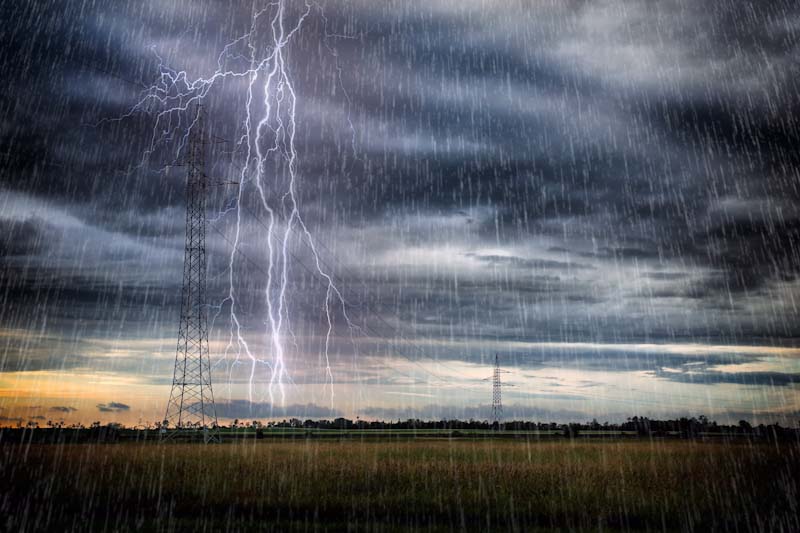Extreme weather events are on the rise, and they’re threatening the resilience of the electric grid. Research conducted by the European Academies' Science Advisory Council has shown that extreme weather events have become more frequent over the last 40 years. As such, 83% of utility companies expect high-impact extreme weather events to affect future grid stability.
This growing risk to grid stability could have an adverse effect on many aspects of society. With transportation becoming increasingly electrified, a rise of renewables, distributed energy generation, and growing industry dependence on electricity, the electric power grid is becoming a single point of failure. Extreme weather events have the potential to shut down critical business and social infrastructure.
We can see the effects of these events in action. In the US, we have recently seen Hurricane Laura take out 219 transmission lines, as well as 292 substations. Additionally, Storm Uri caused 4 million Texan’s to go without power and left the country with a $130 billion repair bill.
With weather events creating a dynamic operational landscape, utility operators need an accurate and real-time digital twin of their grid in order to respond quickly and in a targeted way when disaster strikes.
Renewable energy initiatives are increasing power sources
The complexity of the grid is growing dramatically with renewables and distributed electricity generation. There are a number of initiatives worldwide, including the UN 2030 Agenda for Sustainable Development and the EU Framework 2030, which are helping to accelerate ‘distributed generation’. These initiatives are being bolstered by utility operators, who are sponsoring community solar projects, including the Bright Tucson Community Solar Program. Furthermore, ‘interconnection’, which allows small-scale renewable energy projects to connect to the electric grid, will mean that national grids increasingly draw on these local, community-run power sources. Renewable energy initiatives have increased the number of moving parts on grids.
Similarly to the increase of energy generation sources, energy storage has also become increasingly decentralized. Technologies, such as vehicle-to-grid, are transforming homes and cars into batteries. Experts predict that renewable power grids will have to draw on local power sources to stay agile and resilient against hazards.
Increased power sources are reducing network visibility
At a time when more visibility is needed, the decentralization of energy is causing fragmentation of the network data that is traditionally used to plan, design, and operate electric grids. Utility operators are increasingly implementing a range of smart devices, automating processes, and increasing connectivity to create a digital twin of their physical grid. However, this wide array of data sources is now fragmented across an exponentially increasing number of power sources.
Data, such as damage, degradation, repairs and as-builts, was already difficult to capture, and is now even more challenging because of the new network realities. With generation and storage capacity split across far more people and places, single points of failure are becoming increasingly difficult to identify and mitigate.
We can look at Texas (USA) as a recent example. The state prides itself on having a diverse and decentralized energy grid, including large solar power capabilities and America’s largest wind energy production capacity. However, when Storm Uri hit, a single point of failure was exposed. The storm froze power and distribution systems, including wind turbines and gas pipes. The move away from centralized power generation to a more distributed model means that an event in one location can impact other locations in unpredictable ways.
Operators can learn from incidents to create a more resilient future grid
Texas had the opportunity to prevent Storm Uri from having such a big impact. A decade before the storm, the state faced a deep freeze which highlighted that the grid was vulnerable to cold weather. Texas could have learned from this freeze to mitigate the impact of any future extreme weather incident on the grid.
Unfortunately the opportunity to learn from past events is not always leveraged. Many utilities struggle to institutionalize and implement vital insights from networks due to poor grid modeling and data siloes, which make it difficult or impossible to assess the state of the grid and efficiently respond to rapidly unfolding events.
We have worked with utility companies where as many as 50% of their as-builts are incorrect, and records of damage and degradation are similarly out of date. Many utility operators still rely on paper-based network maps, Excel spreadsheets and apps that cannot integrate and visualize important live data sources. These outdated tools simply cannot keep up with the increasingly decentralized power grid architecture of the future.
Utility operators need to adapt to new challenges so that they can collectively absorb and apply lessons across all parts of their grid, proactively reducing the number of single points of failure to mitigate the impact of extreme weather events.
Japanese operators are a great source of inspiration
Japanese utility operators are well versed when it comes to extreme weather events. They are frequently contending with earthquakes and their often severe annual typhoon season.
As such, one power giant, TEPCO, has responded by creating an IQGeo geospatial digital twin of their network that is easy to use by field crews, open, and accessible on any modern mobile device or web browser. Their mobile solution mimics the decentralized nature of the modern grid, creating a comprehensive and up-to-date overview of grid damage and hazards during storms. TEPCO team members can instantly update their solution with details of field repairs or upgrades, as well as damage, degradation and potential risks. When Typhoon Faxai damaged their network, the system enabled their team to rapidly view and update critical network information, blackout locations and damage in any area. TEPCO’s geospatial solution allows them to effectively and efficiently target resources, as well as incorporate valuable asset damage insights that could inform strategies to protect other assets.
TEPCO’s disaster response strategy could have helped Texas when Storm Uri hit. The geospatial solution could have captured lessons from the previous deep freeze to model the impact of future freezes and implement proactive strategies. Any utility operator can use an IQGeo geospatial solution to integrate grid data with other key data sources, such as local hazards and weather trends, to create proactive and “predictive grids” that continually anticipate and avert hazards before they arise.
The decentralization of power generation means that utility operators now face an increasingly complex grid architecture combined with more frequent and severe weather threats. To respond to these new challenges, operators must create an equally distributed geospatial digital twin of their grid so they can be prepared for anything the future has in store.
4 steps to create a data driven network resilience strategy
We have outlined four steps that have helped our utility customers successfully create an accurate risk picture that supports a stronger network resilience strategy that is essential for an unpredictable future. Read the article.


 Previous
Previous





